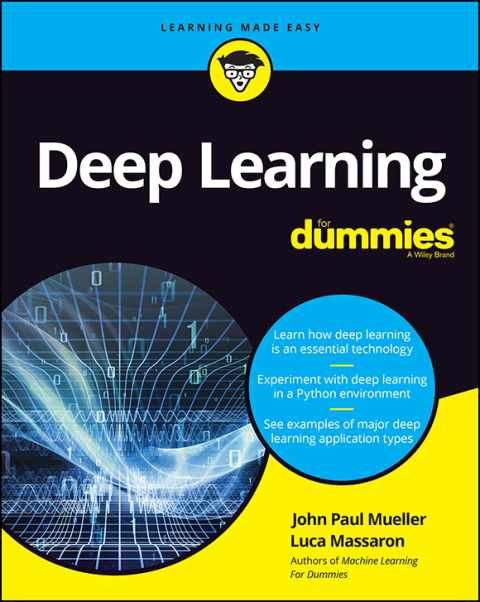Description
Efnisyfirlit
- Cover
- Introduction
- About This Book
- Foolish Assumptions
- Icons Used in This Book
- Beyond the Book
- Where to Go from Here
- Part 1: Discovering Deep Learning
- Chapter 1: Introducing Deep Learning
- Defining What Deep Learning Means
- Using Deep Learning in the Real World
- Considering the Deep Learning Programming Environment
- Overcoming Deep Learning Hype
- Chapter 2: Introducing the Machine Learning Principles
- Defining Machine Learning
- Considering the Many Different Roads to Learning
- Pondering the True Uses of Machine Learning
- Chapter 3: Getting and Using Python
- Working with Python in this Book
- Obtaining Your Copy of Anaconda
- Downloading the Datasets and Example Code
- Creating the Application
- Understanding the Use of Indentation
- Adding Comments
- Getting Help with the Python Language
- Working in the Cloud
- Chapter 4: Leveraging a Deep Learning Framework
- Presenting Frameworks
- Working with Low-End Frameworks
- Understanding TensorFlow
- Part 2: Considering Deep Learning Basics
- Chapter 5: Reviewing Matrix Math and Optimization
- Revealing the Math You Really Need
- Understanding Scalar, Vector, and Matrix Operations
- Interpreting Learning as Optimization
- Chapter 6: Laying Linear Regression Foundations
- Combining Variables
- Mixing Variable Types
- Switching to Probabilities
- Guessing the Right Features
- Learning One Example at a Time
- Chapter 7: Introducing Neural Networks
- Discovering the Incredible Perceptron
- Hitting Complexity with Neural Networks
- Struggling with Overfitting
- Chapter 8: Building a Basic Neural Network
- Understanding Neural Networks
- Looking Under the Hood of Neural Networks
- Chapter 9: Moving to Deep Learning
- Seeing Data Everywhere
- Discovering the Benefits of Additional Data
- Improving Processing Speed
- Explaining Deep Learning Differences from Other Forms of AI
- Finding Even Smarter Solutions
- Chapter 10: Explaining Convolutional Neural Networks
- Beginning the CNN Tour with Character Recognition
- Explaining How Convolutions Work
- Detecting Edges and Shapes from Images
- Chapter 11: Introducing Recurrent Neural Networks
- Introducing Recurrent Networks
- Explaining Long Short-Term Memory
- Part 3: Interacting with Deep Learning
- Chapter 12: Performing Image Classification
- Using Image Classification Challenges
- Distinguishing Traffic Signs
- Chapter 13: Learning Advanced CNNs
- Distinguishing Classification Tasks
- Perceiving Objects in Their Surroundings
- Overcoming Adversarial Attacks on Deep Learning Applications
- Chapter 14: Working on Language Processing
- Processing Language
- Memorizing Sequences that Matter
- Using AI for Sentiment Analysis
- Chapter 15: Generating Music and Visual Art
- Learning to Imitate Art and Life
- Mimicking an Artist
- Chapter 16: Building Generative Adversarial Networks
- Making Networks Compete
- Considering a Growing Field
- Chapter 17: Playing with Deep Reinforcement Learning
- Playing a Game with Neural Networks
- Explaining Alpha-Go
- Part 4: The Part of Tens
- Chapter 18: Ten Applications that Require Deep Learning
- Restoring Color to Black-and-White Videos and Pictures
- Approximating Person Poses in Real Time
- Performing Real-Time Behavior Analysis
- Translating Languages
- Estimating Solar Savings Potential
- Beating People at Computer Games
- Generating Voices
- Predicting Demographics
- Creating Art from Real-World Pictures
- Forecasting Natural Catastrophes
- Chapter 19: Ten Must-Have Deep Learning Tools
- Compiling Math Expressions Using Theano
- Augmenting TensorFlow Using Keras
- Dynamically Computing Graphs with Chainer
- Creating a MATLAB-Like Environment with Torch
- Performing Tasks Dynamically with PyTorch
- Accelerating Deep Learning Research Using CUDA
- Supporting Business Needs with Deeplearning4j
- Mining Data Using Neural Designer
- Training Algorithms Using Microsoft Cognitive Toolkit (CNTK)
- Exploiting Full GPU Capability Using MXNet
- Chapter 20: Ten Types of Occupations that Use Deep Learning
- Managing People
- Improving Medicine
- Developing New Devices
- Providing Customer Support
- Seeing Data in New Ways
- Performing Analysis Faster
- Creating a Better Work Environment
- Researching Obscure or Detailed Information
- Designing Buildings
- Enhancing Safety
- Index
- About the Authors
- Advertisement Page
- Connect with Dummies
- End User License Agreement






Reviews
There are no reviews yet.